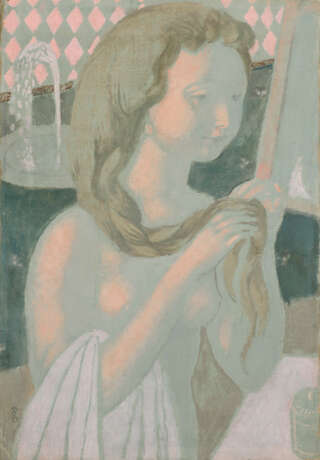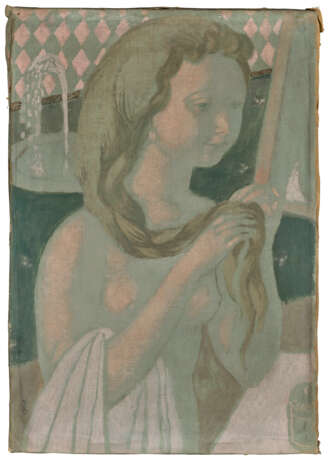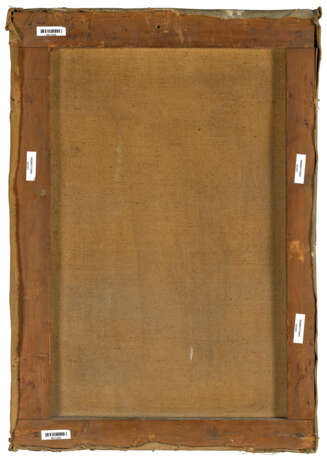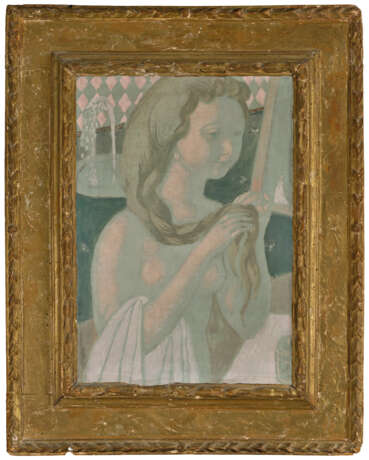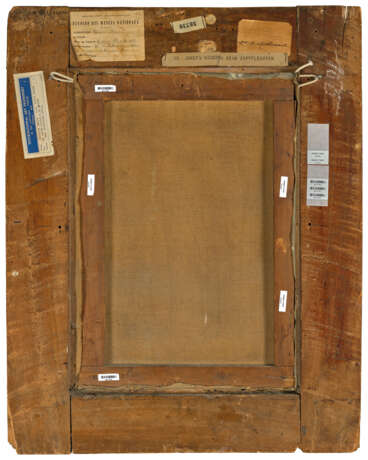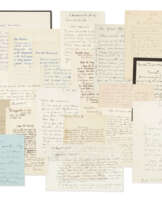ID 930189
Lot 134 | Maurice Denis (1870-1943)
Estimate value
€ 80 000 – 120 000
Jeune Fille à la natte
monogrammé (en bas à gauche)
huile sur toile
48 x 33.3 cm.
Peint vers 1895
signed with the monogram (lower left)
oil on canvas
19 x 13 1/8 in.
Painted circa 1895
Provenance
Adrien Mithouard, Paris (acquis auprès de l'artiste en 1897).
Puis par descendance au propriétaire actuel.
Literature
Paris, Galerie Samuel Bing, Salon de L'Art Nouveau, décembre 1895-janvier 1896, no. 71 (la frise en sept panneaux titrée 'Frauenliebe und Leben').
Paris, Musée d'Art Moderne, Exposition Maurice Denis, 1945, p. 23-24, no. 21 (daté 'vers 1892').
Paris, Orangerie des Tuileries, Maurice Denis, juin-août 1970, p. 31, no. 47 (illustré).
Paris, Musée Bourdelle, Trois ge´ne´rations d'artistes, Maurice Denis, Marcel Poncet, Antoine Poncet, juin-septembre 1979, no. 26 (illustré, pl. VI).
Post lot text
Après avoir guidé le pinceau et le choix des couleurs de Paul Sérusier pour son Talisman peint en octobre 1888 (Musée d'Orsay, Paris), Paul Gauguin réunit autour d’une sensibilité nouvelle de jeunes étudiants de l'Académie Julien à Paris parmi lesquels figurent Maurice Denis, Pierre Bonnard, Paul-Élie Ranson ou encore Édouard Vuillard.
Ces derniers, qui forment alors le groupe des Nabis, partagent une même culture picturale à la fois symbolique, synthétique et spirituelle ; la couleur est alors perçue comme ornement musical de l’âme : « Les formes et les couleurs ne sont plus utilisées pour leur valeur imitative du réel mais pour leur valeur sensible, leur capacité à susciter des états de conscience » (cité in Le Talisman de Paul Sérusier, Une prophétie de la couleur, cat. exp., Musée d’Orsay, Paris, p. 59).
Véritable tour de force peint vers 1895, Jeune Fille à la natte incarne véritablement cette « surface plane recouverte de couleurs », dont le récit puissant empli d’éléments symbolistes, concentre l’esthétique Nabi chère à Maurice Denis.
La présente œuvre à la douceur et la délicatesse inouïes, incarne à la fois l’importance du Décor pour les Nabis et le lien d’amitié entre Maurice Denis et Adrien Mithouard (1864-1919).
Pour l'ouverture de sa nouvelle galerie L'Art nouveau, le marchand d'art Siegfried Bing (1838-1905) commande plusieurs œuvres décoratives aux Nabis, à l’instar de Maurice Denis, qui réalise pour ce dernier sept panneaux décoratifs pour une chambre à coucher, parmi lesquels figure La Jeune Fille à la natte. Le thème retenu par Denis - L’Amour et la vie d’une femme (1840), cycle de Robert Schumann - lui permet représenter des épisodes marquants de l’existence féminine, de la passion amoureuse à la maternité tout en faisant écho à son amour naissant pour sa muse éternelle, Marthe Meurier.
Peint dans une tonalité crépusculaire dominée par de subtiles nuances de bleu et de violet et manifeste de l’influence des primitifs italiens et de Puvis de Chavannes, le présent tableau est l’un des deux rares panneaux de cet ensemble, qui soit arrivé jusqu’à nous.
L’historique de cet ensemble est en effet particulièrement fascinant : « L'essentiel des panneaux, aujourd'hui disparus, n'est connu que par des reproductions anciennes. En l'absence de documents photographiques de la chambre in situ, l'ordre des sections de cette frise est longtemps resté incertain […] jusqu'à la découverte récente d'un croquis annoté de la main de l'artiste, qui permet de reconstituer la configuration du décor […] Siefried Bing, qui supervisait l'aménagement des différents espaces, était préoccupé d'harmoniser l'ameublement avec les lignes et les couleurs de la frise peinte préparée par Denis; il lui proposa des meubles d'Émile Gallé, refusés par le peintre qui préféra dessiner lui-même les pièces de mobilier. Résultat sans appel lors de l'inauguration: l'ensemble ne plaît pas, les réactions négatives de la critique sont unanimes, et Bing demande à Denis de venir récupérer ses peintures et pièces d'ameublement au plus tôt. Ainsi, la frise sur laquelle l'artiste avait travaillé de longs mois ne fut présentée au public que quinze jours... » (cité in Les Nabis & Le Décor, Bonnard, Vuillard, Maurice Denis, cat. exp., Musée du Luxembourg, Paris, 2019, p. 174).
Peu après cette courte exposition, Adrien Mithouard, poète et essayiste français, cofondateur de la revue L’Occident et ami proche de Maurice Denis, acquis La Jeune fille à la natte directement auprès de l’artiste et Maurice Denis, très attaché à ce décor, réalise quant à lui à la fin des années 1890 une nouvelle version pour la chambre de son épouse Marthe, frise qui connaît plusieurs ajouts et modifications.
La présente œuvre est restée dans la famille Mithouard jusqu’à aujourd’hui.
After having influenced the brushwork and colour choices of Paul Sérusier's Talisman painted in October 1888 (Musée d'Orsay, Paris), Paul Gauguin gathered a group of young students from the Académie Julien in Paris who embraced a new sensibility. The members included Maurice Denis, Pierre Bonnard, Paul-Élie Ranson and Édouard Vuillard.
They became known as the Nabis and shared a pictorial culture that was simultaneously symbolic, synthetic and spiritual. To them, colour is perceived as a musical adornment of the soul: "Shapes and colours are no longer used for their ability to imitate reality, but for their ability to convey sensation and to provoke states of consciousness" (quoted in Paul Sérusier's Talisman, A Prophecy of Colour, exh. cat. Musée d'Orsay, Paris, p. 59).
A true tour de force painted in 1895, Jeune Fille à la natte embodies the "flat surface covered with colours" whose powerful narrative filled with symbolist components is a concentration of the Nabi aesthetic dear to Maurice Denis.
This work, with its unprecedented softness and delicacy, embodies both the importance of Decor for the Nabis and the friendship between Maurice Denis and Adrien Mithouard (1864-1919).
For the opening of his new gallery L'Art Nouveau, the art dealer Siegfried Bing (1838-1905) commissioned several decorative works from the Nabis, like Maurice Denis, who produced seven decorative panels for a bedroom for the latter, including Jeune Fille à la natte. The theme chosen by Denis - Amour et la vie d’une femme (1840), a cycle by Robert Schumann - enabled him to depict key episodes in women's lives, from passion in love to motherhood, while echoing his budding love for his eternal muse, Marthe Meurier.
Painted in a twilight tone dominated by subtle shades of blue and violet and showing the influence of the Italian primitives and Puvis de Chavannes, this painting is one of the two rare panels of this group that has come down to us.
The history of this set is indeed particularly fascinating: "Most of the panels, which have now disappeared, are known only through old reproductions. In the absence of photographic documentation of the room in situ, the order of the sections of this frieze remained uncertain for a long time [...] until the recent discovery of a sketch annotated in the artist's hand, which makes it possible to reconstruct the configuration of the decor [...] Siegfried Bing, who supervised the layout of the various spaces, was concerned to harmonise the furnishings with the lines and colours of the painted frieze prepared by Denis; he suggested furniture by Emile Gallé, which was refused by the painter, who preferred to design the furniture himself. The result was clear at the inauguration: the whole thing did not appeal, the critics were unanimous in their negative reactions, and Bing asked Denis to come and collect his paintings and furniture as soon as possible. Thus, the frieze on which the artist had worked for many months was only presented to the public for two weeks..." (quoted in Les Nabis & Le Décor, Bonnard, Vuillard, Maurice Denis, exh. Cat., Musée du Luxembourg, Paris, 2019, p. 174).
Soon after this short exhibition, Adrien Mithouard, French poet and essayist who co-founded the magazine L'Occident and a close friend of Maurice Denis, acquired Jeune Fille à la natte directly from the artist, and Maurice Denis, who was very attached to this decor, produced a new version for his wife Marthe's bedroom at the end of the 1890s, a frieze which underwent several additions and modifications.
This work has remained in the Mithouard family to this day.
| Artist: | Maurice Denis (1870 - 1943) |
|---|---|
| Applied technique: | Oil on canvas |
| Auction house category: | Paintings |
| Artist: | Maurice Denis (1870 - 1943) |
|---|---|
| Applied technique: | Oil on canvas |
| Auction house category: | Paintings |
| Address of auction |
CHRISTIE'S 9 Avenue Matignon 75008 Paris France | ||||||||||||||
|---|---|---|---|---|---|---|---|---|---|---|---|---|---|---|---|
| Preview |
| ||||||||||||||
| Phone | +33 (0)1 40 76 85 85 | ||||||||||||||
| Fax | +33 (0)1 40 76 85 86 | ||||||||||||||
| Conditions of purchase | Conditions of purchase | ||||||||||||||
| Shipping |
Postal service Courier service pickup by yourself | ||||||||||||||
| Payment methods |
Wire Transfer | ||||||||||||||
| Business hours | Business hours
|
